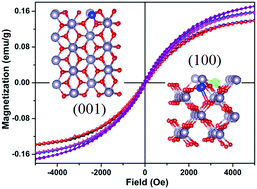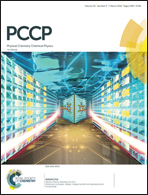An insight into the origin of room-temperature ferromagnetism in SnO2 and Mn-doped SnO2 quantum dots: an experimental and DFT approach†
Abstract
SnO2 and Mn-doped SnO2 single-phase tetragonal crystal structure quantum dots (QDs) of uniform size with control over dopant composition and microstructure were synthesized using the high pressure microwave synthesis technique. On a broader vision, we systematically investigated the influence of dilute Mn ions in SnO2 under the strong quantum confinement regime through various experimental techniques and density functional theoretical (DFT) calculations to disclose the physical mechanism governing the observed ferromagnetism. DFT calculations revealed that the formation of the stable (001) surface was much more energetically favorable than that of the (100) surface, and the formation energy of the oxygen vacancies in the stable (001) surface was comparatively higher in the undoped SnO2 QDs. X-ray photoelectron spectroscopy (XPS) and first-principles modeling of doped QDs revealed that the lower doping concentration of Mn favored the formation of MnO-like (Mn2+) structures in defect-rich areas and the higher doping concentration of Mn led to the formation of multiple configurations of Mn (Mn2+ and Mn3+) in the stable surfaces of SnO2 QDs. Electronic absorption spectra indicated the characteristic spin allowed ligand field transitions of Mn2+ and Mn3+ and the red shift in the band gap. DFT calculations clearly indicated that only the substitutional dopant antiferromagnetic configurations were more energetically favorable. The gradual increase of magnetization at a low level of Mn-doping could be explained by the prevalence of antiferromagnetic manganese-vacancy pairs. Higher concentrations of Mn led to the appearance of ferromagnetic interactions between manganese and oxygen vacancies. The increase in the concentration of metallic dopants caused not just an increase in the total magnetic moment of the system but also changed the magnetic interactions between the magnetic moments on the metal ions and oxygen. The present study provides new insight into the fundamental understanding of the origin of ferromagnetism in transition metal-doped QDs.



 Please wait while we load your content...
Please wait while we load your content...